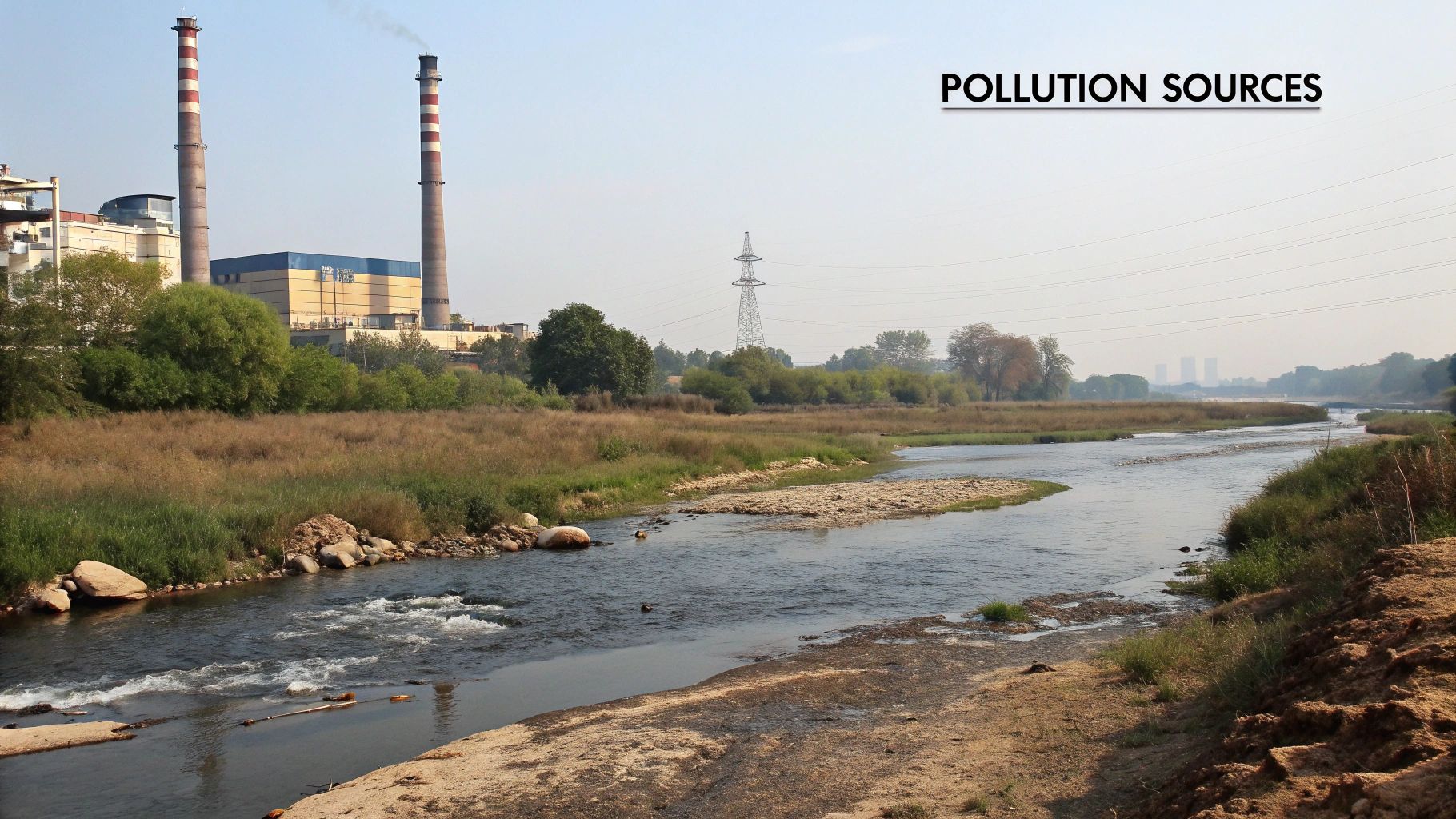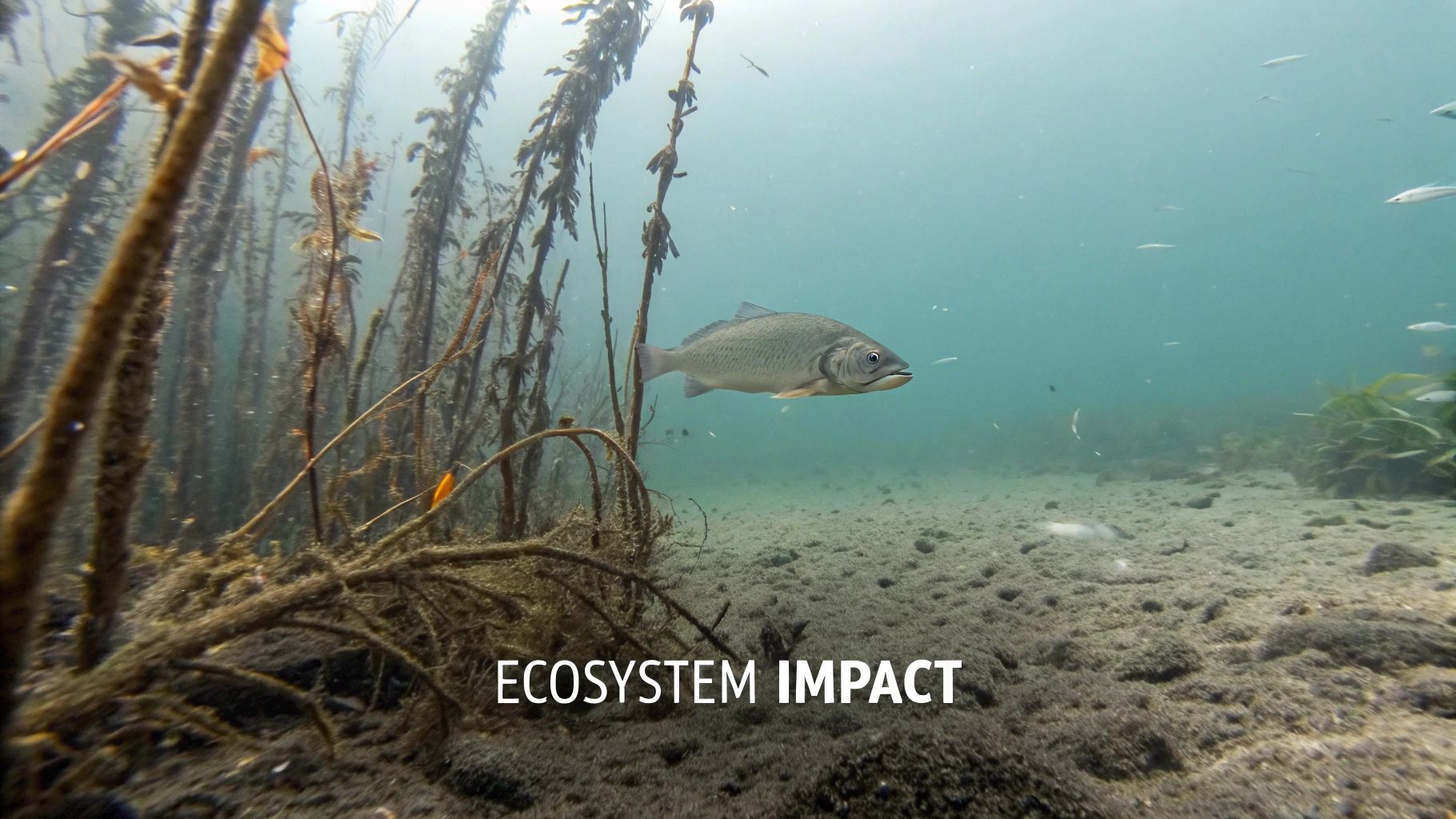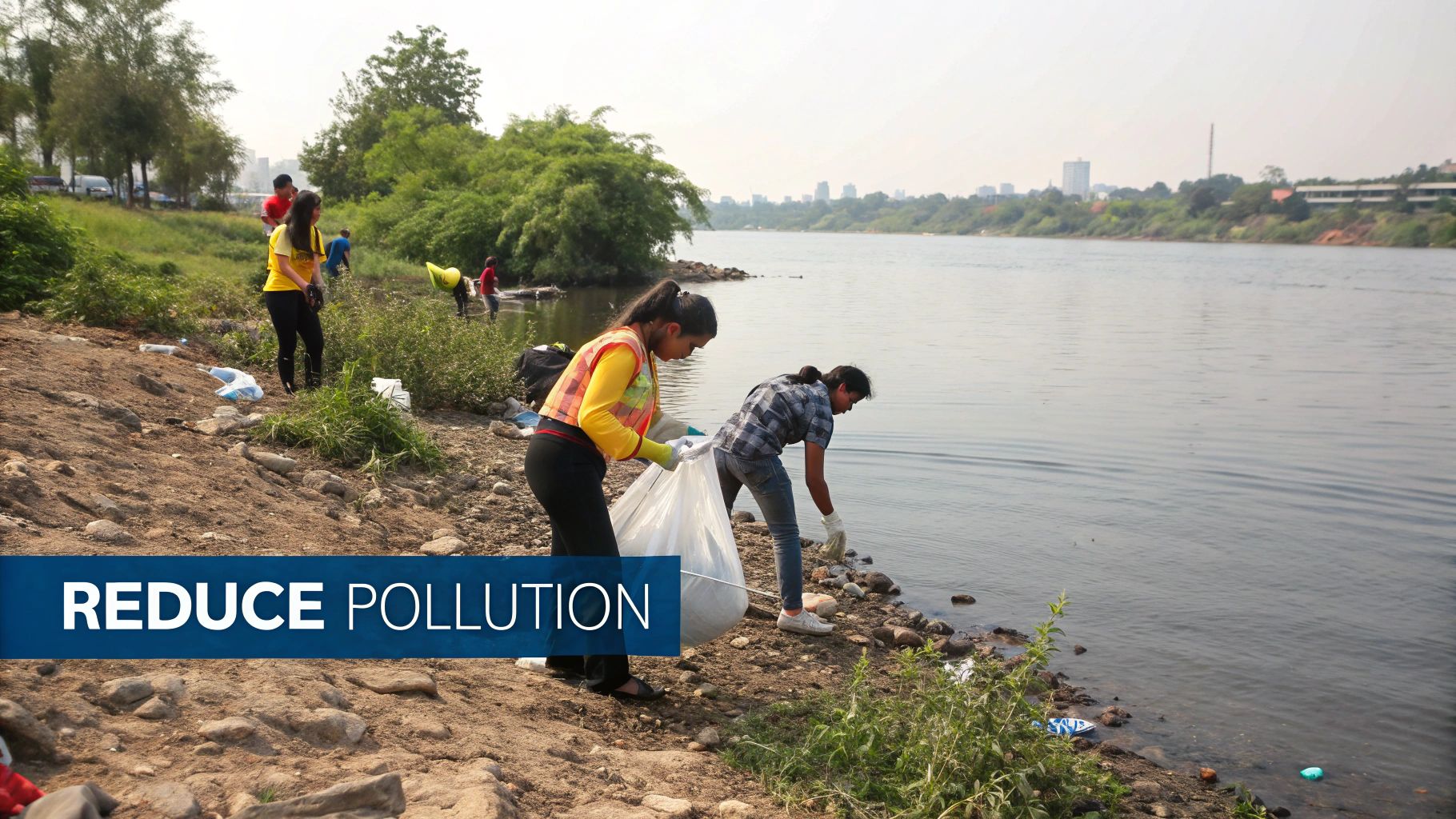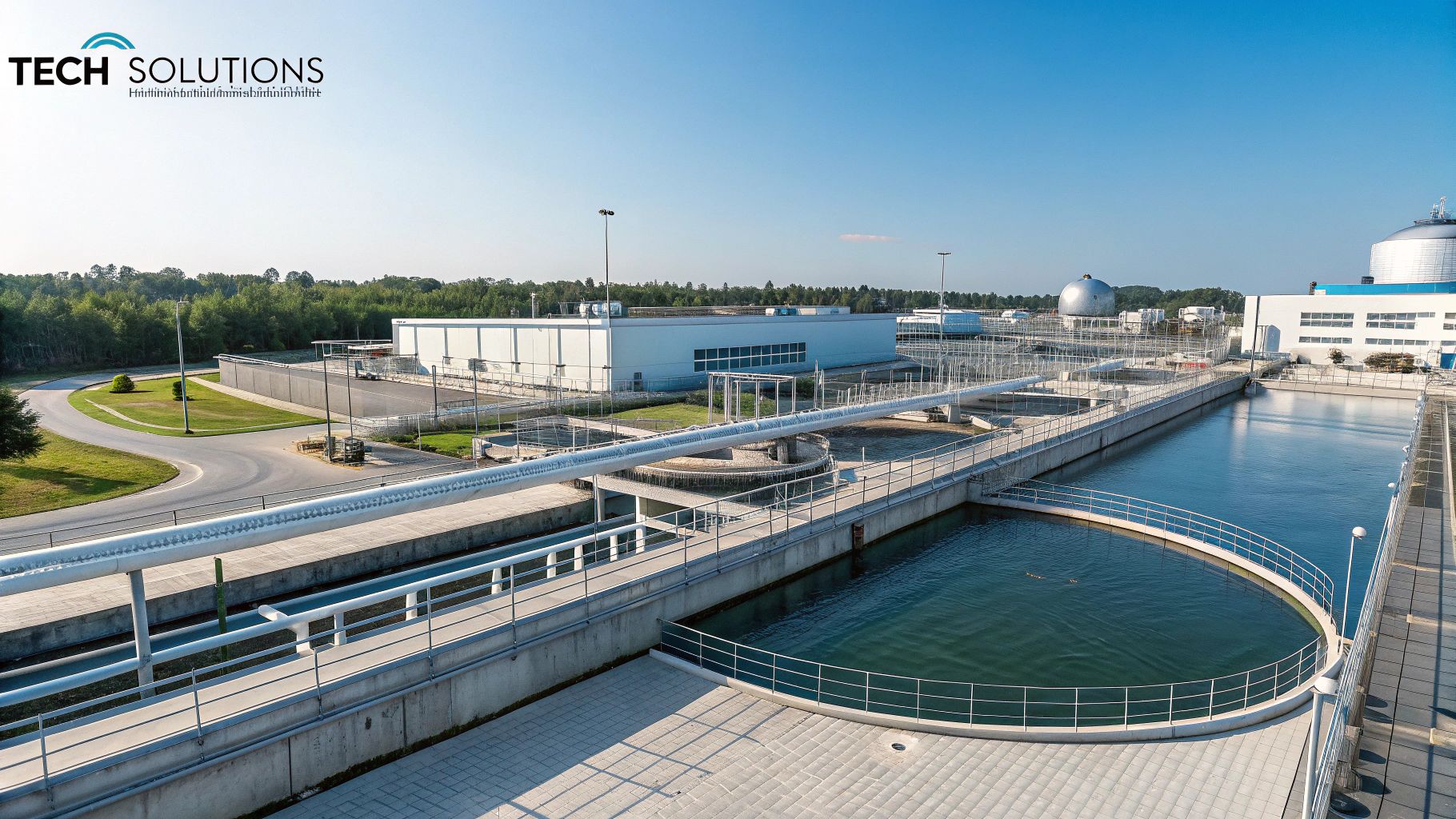Understanding the Real Impact of Water Pollution
Water pollution isn't just an environmental problem; it deeply affects both ecosystems and human health. Industrial wastewater, often containing heavy metals and toxic chemicals, directly poisons aquatic life and disrupts delicate ecological balances. Agricultural runoff, full of fertilizers and pesticides, creates dead zones by causing excessive algae growth, which depletes oxygen and suffocates fish and other aquatic life. This disrupts the food chain and can collapse entire ecosystems.
Even everyday household activities contribute to the problem. Many common cleaning products contain phosphates and other chemicals that end up in our water systems. These pollutants can linger in the environment, accumulating in aquatic organisms and moving up the food chain to our dinner plates. Improper disposal of medications and personal care products adds pharmaceuticals and microplastics to our water, making the problem worse. Water pollution is a global issue, with a significant amount of wastewater not treated properly. About 42% of household wastewater lacks proper treatment, impacting both ecosystems and human health. Find more detailed statistics here
The Invisible Threat: Microplastics and Pharmaceuticals
Microplastics, tiny particles from the breakdown of larger plastics, are everywhere in our waterways. These often invisible particles are ingested by marine life, harming their digestive systems and potentially introducing dangerous chemicals into the food chain. Pharmaceuticals, flushed down toilets or improperly discarded, add to the mix of pollutants in our water. These can have unpredictable effects on aquatic life, disrupting hormones and possibly contributing to antibiotic resistance.
The Economic Consequences of Inaction
The impact of water pollution goes beyond the environment; it has significant economic consequences. Cleaning polluted waterways, treating contaminated drinking water, and addressing the health impacts of waterborne illnesses are costly. Adopting practices focused on sustainability is vital; for an in-depth look, explore sustainable business growth strategies. Polluted water can also harm tourism and decrease property values. These financial burdens highlight the need to prevent water pollution rather than resorting to expensive cleanup efforts. Investing in sustainable practices and technologies that reduce water pollution is environmentally and economically responsible.
Protecting Our Shared Resource: A Collective Responsibility
Reducing water pollution requires a multifaceted approach. Individual actions, like choosing eco-friendly products and disposing of waste properly, are important first steps. However, larger systemic changes are also necessary. These include stricter regulations on industrial discharge, promoting sustainable agriculture, and investing in advanced wastewater treatment technologies. By understanding how our actions impact water quality and working together on solutions, we can protect this essential resource for the future.
Household Solutions That Actually Make a Difference

While large-scale changes are essential for tackling water pollution, our individual actions at home can also have a significant impact. By understanding which household products pose the biggest threats to our water systems, we can make smarter choices. This involves moving away from harmful chemicals and choosing safe, affordable alternatives. Don't worry, this doesn't mean a complete lifestyle change. Small, consistent changes can add up to a big difference.
Rethinking Everyday Products
Many everyday household cleaners, detergents, and personal care products contain chemicals that pollute our water. For example, phosphates found in some detergents can lead to algal blooms. These blooms deplete oxygen in the water, harming aquatic life. Similarly, triclosan, a chemical found in many antibacterial soaps, can disrupt the endocrine systems of aquatic organisms.
Luckily, eco-friendly alternatives are easy to find. Switching to phosphate-free detergents, natural cleaning solutions, and biodegradable soaps can significantly reduce your impact on water pollution. These alternatives are often similarly priced and just as effective. Carefully reading product labels and doing a little research is key to making informed decisions.
To help you get started, here's a table comparing common household pollutants with their eco-friendly counterparts:
Common Household Pollutants and Alternatives
| Polluting Product | Environmental Impact | Eco-Friendly Alternative | Cost Comparison |
|---|---|---|---|
| Phosphate-based detergents | Algal blooms, oxygen depletion | Phosphate-free detergents | Similar |
| Triclosan-containing soaps | Endocrine disruption in aquatic life | Biodegradable soaps | Similar |
| Conventional household cleaners (containing ammonia, bleach, etc.) | Toxic to aquatic life, contributes to chemical pollution | Natural cleaning solutions (vinegar, baking soda, etc.) | Often cheaper |
| Chemical pesticides | Contaminates water sources, harms beneficial insects | Natural pest control methods (diatomaceous earth, beneficial insects) | Varies, can be cheaper in the long run |
This table provides a quick overview of some simple swaps you can make in your home. By choosing these alternatives, you can significantly reduce your household's contribution to water pollution.
Proper Disposal Practices
How we dispose of household products is just as important as the products we use. Never pour hazardous chemicals down the drain. Products like paint thinners or pesticides should be taken to designated hazardous waste collection sites. Also, think twice before flushing medications down the toilet. This introduces pharmaceuticals into our water systems.
Many pharmacies offer take-back programs for safe medication disposal. This is a critical step in preventing pharmaceuticals from contaminating our water. Check out our guide on How to master sitemaps for further insights.
Minimizing Microplastics
Microplastics, tiny plastic particles shed from synthetic clothing during washing, are another major source of water pollution from our homes. Using a washing machine filter designed to catch microplastics can significantly reduce the number of these particles released into the water system.
Choosing natural fibers like cotton or wool over synthetics also helps minimize the source of microplastics in your laundry. These simple steps can prevent countless microplastic particles from polluting our water.
From Kitchen to Bathroom: A Room-by-Room Approach
Making these changes doesn't have to be overwhelming. Focus on one room at a time. In the kitchen, switch to eco-friendly dish soap and cleaning products. In the bathroom, replace conventional personal care products with natural alternatives.
Gradually implementing changes room by room makes the transition easier. This method allows you to develop sustainable habits that benefit our water systems. By taking consistent action in our homes, we actively participate in reducing water pollution and create a positive impact.
Collective Action: Building Community Water Guardianship
Individual actions to reduce water pollution are important. However, when combined with community efforts, these actions have a much larger impact. Real, lasting change comes from a shared sense of responsibility for our water. This section explores how citizens, working together, can become strong advocates for clean water.
Community Monitoring: Empowering Citizen Scientists
One effective way to protect water is through citizen science monitoring programs. These programs empower residents to collect samples, analyze data, and identify pollution sources. For example, some community initiatives have successfully identified illegal industrial discharges and failing septic systems. This leads to faster intervention and cleanup.
Influencing Policy: Data-Driven Advocacy
Data from citizen scientists provides valuable evidence for advocating policy changes. This data can persuade local governments to strengthen regulations. For example, they might invest in better wastewater treatment or enforce existing laws more strictly. Community monitoring not only identifies pollution, but also empowers residents to hold polluters accountable.
Building Partnerships: Engaging Local Businesses
Collaboration between communities and local businesses is crucial for water protection. Businesses can adopt sustainable practices, reduce water usage, and manage wastewater discharge properly. Restaurants, for example, can install grease traps. Car washes can implement water recycling systems. These partnerships create a shared commitment to water quality.
Green Infrastructure: Beautiful and Functional Solutions
Community-based green infrastructure projects offer a natural way to reduce pollution. Rain gardens, designed to absorb rainwater, are a prime example. They filter pollutants and reduce runoff. These gardens not only improve water quality, but also beautify public spaces. They can also reduce flooding and provide habitats for pollinators. Similar projects, like permeable pavements and green roofs, can create healthier communities. International cooperation is also important. The lack of agreements on shared water resources makes reducing pollution more difficult. There are over 468 internationally shared aquifers, but only six have formal agreements. This limits collaborative management and pollution control. Stronger international partnerships are essential for addressing these issues. Learn more about the risk of a global water crisis here: https://www.unesco.org/en/articles/imminent-risk-global-water-crisis-warns-un-world-water-development-report-2023
Mobilizing Your Community: A Step-by-Step Guide
-
Engage your neighbors: Start conversations about water quality and possible solutions.
-
Form a coalition: Bring together residents, organizations, and businesses.
-
Develop a plan: Identify specific goals, strategies, and timelines.
-
Secure funding: Explore grants, donations, and partnerships.
-
Maintain momentum: Celebrate successes and address challenges openly.

By working together, communities can achieve much more than individuals. Building a community water guardianship program protects water resources, strengthens community bonds, and empowers citizens to make a difference.
Transforming Agriculture's Relationship With Water

Agriculture is often a major source of water pollution. However, new farming methods are changing this, offering solutions that protect our water and keep farms productive. This change involves using technology and working with natural processes. This represents an important step towards sustainable agriculture.
Precision Farming: Targeting Nutrients, Minimizing Waste
One exciting development is precision farming. Precision farming uses technology to apply water and fertilizer only where and when crops need them. This reduces excess runoff, a significant source of water pollution. For example, GPS-guided tractors with sensors can adjust fertilizer application rates across a field based on the soil's nutrient levels.
This targeted approach reduces fertilizer waste, saving farmers money and reducing chemicals entering waterways. It also boosts crop yields by ensuring plants get the right amount of nutrients. Ultimately, this approach contributes to a more sustainable agricultural system.
Regenerative Agriculture: Restoring Soil Health, Protecting Water
Regenerative agriculture prioritizes soil health. Healthy soil acts like a sponge, absorbing water and reducing runoff. Key practices include no-till farming, minimizing soil disruption, and cover cropping, keeping soil covered with plants to prevent erosion. For instance, planting cover crops like rye or clover in the off-season improves soil structure and can reduce nutrient runoff by as much as 50%.
These practices also help store carbon in the soil, combating climate change. Regenerative agriculture also supports biodiversity, leading to healthier and more robust ecosystems. You can explore more resources like How to master sitemaps for further understanding.
The Economics of Sustainability: Profitability Through Efficiency
Switching to sustainable farming often benefits farmers financially. Reduced fertilizer and water use lowers input costs. Improved soil health leads to better yields over time. Consumers are also increasingly willing to pay more for sustainably produced food.
Transitioning to Sustainable Practices: A Gradual Approach
Changing established farm practices requires time and planning. Starting with small tests of new methods helps farmers evaluate effectiveness and adapt. Local agricultural extension offices can be valuable resources for farmers looking to adopt sustainable practices.
The table below shows the impact of different agricultural practices on water quality. It compares conventional methods with sustainable alternatives and their potential to reduce pollution.
| Agricultural Practice | Water Pollution Impact | Sustainable Alternative | Pollution Reduction Potential |
|---|---|---|---|
| Conventional Tillage | High soil erosion, increased runoff | No-Till Farming | Significant reduction in runoff and erosion |
| Synthetic Fertilizer Application | Nutrient runoff, algal blooms | Precision Farming, Cover Cropping | Reduced nutrient runoff |
| Monoculture Cropping | Reduced biodiversity, increased pest susceptibility | Crop Rotation, Diversification | Improved biodiversity, reduced pest pressure |
| Excessive Irrigation | Water waste, runoff | Water-efficient irrigation techniques | Reduced water consumption and runoff |
This table summarizes the impacts of common farming methods and their sustainable alternatives. As you can see, sustainable options offer substantial benefits for water quality.
By adopting sustainable agriculture, we can transform agriculture from a polluter to a protector of our water. This shift benefits the environment and ensures the long-term success of the agricultural industry.
Breakthrough Technologies Cleaning Our Water Systems
Building on community-led initiatives and sustainable agricultural practices, advancements in water treatment technologies offer new solutions for reducing water pollution. These technologies address pollution at various levels, from individual homes to large-scale treatment facilities, providing hope for cleaner water in the future.
Bioremediation: Harnessing Nature's Power
Bioremediation uses microorganisms like bacteria and fungi to break down pollutants. These organisms consume pollutants, transforming them into harmless substances like water and carbon dioxide. It's similar to composting organic waste, but for water.
This natural process reduces the need for harsh chemicals, minimizing the environmental impact of pollution cleanup. For instance, certain bacteria can break down harmful petroleum hydrocarbons, effectively cleaning up oil spills and contaminated groundwater.
Advanced Filtration: Removing Pollutants at the Molecular Level
Advanced filtration systems go beyond bioremediation, removing even the smallest pollutants. Systems like reverse osmosis and nanofiltration filter water at the molecular level. They remove contaminants such as heavy metals, pesticides, and pharmaceuticals.
Reverse osmosis, for example, uses pressure to force water through a semipermeable membrane. This removes dissolved salts, minerals, and other impurities, creating safe drinking water. These methods are crucial for treating industrial wastewater. They ensure that the water released back into the environment meets quality standards, protecting both ecosystems and human health.
AI-Powered Monitoring: Early Detection and Rapid Response
Artificial intelligence (AI) plays a growing role in water quality monitoring. AI-powered sensors continuously monitor water bodies, detecting contamination in real-time. This allows for a much faster response to pollution events.
AI algorithms also analyze data to identify pollution sources. This information provides valuable insights for preventing future incidents. This proactive approach to water management helps prevent large-scale contamination, protecting our precious water resources.
Scaling Solutions: From Industry to Community
Many of these technologies are first used in industrial settings, but they are increasingly adapted for community water systems. Constructed wetlands, a type of bioremediation, can treat wastewater in smaller communities. This offers an economical and environmentally friendly way to treat water locally.
Similarly, advanced filtration systems are being incorporated into home water purification units, giving individuals and families access to clean drinking water. This decentralized approach is particularly important for rural areas or those with limited access to municipal water. The cost of these technologies varies depending on the type and scale. However, cleaner water, healthier ecosystems, and reduced healthcare costs often make it a worthwhile investment.
Nature's Purifiers: Harnessing Wetlands and Watersheds
Nature provides incredibly effective water purification systems in the form of wetlands and watersheds. These natural systems often surpass human-engineered solutions, not only in cleaning water but also in offering additional benefits like flood control. By safeguarding and restoring these crucial ecosystems, we can dramatically reduce water pollution and bolster overall environmental well-being. This represents a sustainable, long-term approach to cleaner water.
Wetlands: Nature's Filtration System
Wetlands function as natural sponges and filters. They capture pollutants from runoff before they contaminate larger bodies of water. Plants within wetlands absorb excess nutrients, such as nitrogen and phosphorus, common agricultural pollutants. This absorption helps prevent algal blooms in lakes and rivers.
Wetlands also decelerate water flow, which allows sediment and other pollutants to settle. This natural sedimentation process eliminates heavy metals and other harmful substances from the water. Different types of wetlands possess varying filtration capacities. For example, tidal marshes excel at filtering pollutants from coastal runoff, while freshwater swamps play a vital role in purifying inland waterways.
Specific plant species within wetlands are essential for this filtration process. For instance, cattails effectively absorb excess nutrients, while sphagnum moss acts as a natural filter, trapping sediment and pollutants. Protecting these plant species is critical to preserving the health and functionality of wetland ecosystems.
Watershed Protection: A Holistic Approach
A watershed encompasses the land area where all water drains into a shared body of water, such as a river or lake. Protecting the entire watershed offers a holistic approach to minimizing water pollution. By thoughtfully managing land use and reducing pollution sources within the watershed, we safeguard the water at its origin.
Shielding forests and other natural vegetation within a watershed helps prevent soil erosion and minimizes runoff, which can transport pollutants into waterways. Implementing sustainable agricultural practices, as previously discussed, lessens the negative effects of farming on water quality.
Economic Benefits: Beyond Clean Water
Protecting and restoring wetlands and watersheds brings economic advantages that extend beyond simply having clean water. Wetlands serve as natural buffers, absorbing floodwaters and mitigating flood damage. They also sequester carbon, contributing to climate change mitigation. Moreover, healthy wetlands and watersheds create recreational opportunities, boosting local economies through tourism and outdoor activities.
Supporting Conservation Efforts: Making a Difference
There are numerous ways to participate in protecting these natural purifiers:
- Support existing conservation organizations: Many organizations actively work to protect and restore wetlands and watersheds. Donating to or volunteering with these organizations directly supports their important work.
- Participate in local restoration projects: Community-based restoration efforts often involve planting native vegetation, removing invasive species, and cleaning up debris. These projects provide a direct way to enhance local water quality.
- Advocate for natural infrastructure: Encourage local government to integrate natural solutions, like constructed wetlands, into development plans. These nature-based solutions often prove more cost-effective and environmentally sound than traditional infrastructure.
By collaborating, we can utilize the power of nature to reduce water pollution and safeguard our water resources for future generations. Investing in these natural solutions yields both environmental and economic benefits for communities.
Your Water Protection Roadmap: From Intention to Impact

Concerned about water pollution? Turning that concern into action starts with a plan. This section offers a practical framework for developing a personalized water protection plan. Your plan will be unique to you, based on your individual circumstances, available resources, and the impact you want to make. The goal is sustainable change, not temporary fixes.
Assessing Your Water Footprint
The first step is understanding your current impact. Think about your daily habits: What products do you use? How do you dispose of waste? Even seemingly small actions, like using certain cleaning products or pouring chemicals down the drain, can contribute to pollution.
For example, phosphate-based detergents can lead to algal blooms in waterways. Improper disposal of medications introduces pharmaceuticals into the water system. Awareness of these everyday impacts lays the groundwork for effective change. Learn more in our article about how to master sitemaps.
Identifying High-Impact Opportunities
Once you understand your impact, identify areas where you can make the biggest difference. Perhaps it’s switching to eco-friendly cleaning products, reducing plastic consumption to minimize microplastics, or advocating for better water management practices in your community.
Prioritize actions aligned with your resources and passions. Maybe you could install a rain barrel to reduce runoff. Or perhaps you could volunteer for a local river cleanup. Focusing on achievable changes makes sustained progress more likely.
Creating Sustainable Habits
Real change comes from consistent effort. Weave water-conscious practices into your daily routine. This could involve simple swaps like using reusable water bottles and shopping bags. Or it might involve bigger changes like installing a greywater recycling system.
Sustainability is about progress, not perfection. Start small, track your progress, and celebrate your achievements. This boosts motivation and reinforces those positive habits. Building a support network can also be helpful. Connecting with others committed to water protection offers encouragement and inspiration.
Measuring Progress and Maintaining Momentum
Tracking your progress is key for staying motivated. This might involve monitoring your water usage, documenting the eco-friendly products you use, or noting your involvement in community initiatives. Seeing your progress reinforces positive behavior and shows you the real impact of your efforts.
Challenges are inevitable. Building resilience is crucial for long-term success. Connecting with other water advocates, learning from their experiences, and celebrating shared victories can help you stay on track and overcome obstacles. Remember, even small changes contribute to a larger collective impact.
From Individual Action to Collective Change
Individual actions are important, but collective action multiplies their impact. Engage with your community, advocate for stronger environmental policies, and support organizations dedicated to protecting water resources. By working together, we become a powerful force for change.
Real-world examples show how ordinary people have made extraordinary impacts. From community-led river cleanups to citizen science monitoring programs, individuals are making a tangible difference in protecting our shared water resources. These stories inspire and empower others to join the movement.
Take the next step in protecting our waters with CLiX Fueling Solutions, an innovative product that prevents fuel spills and protects our marine ecosystems. Learn more and make a difference.











